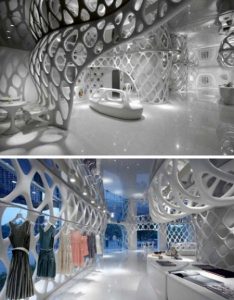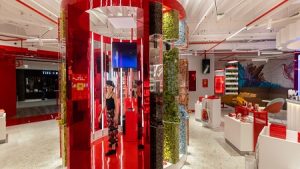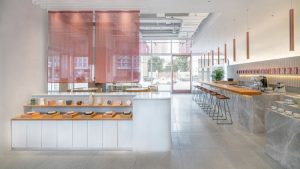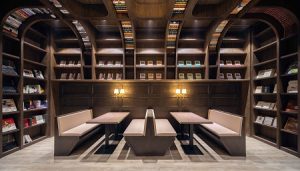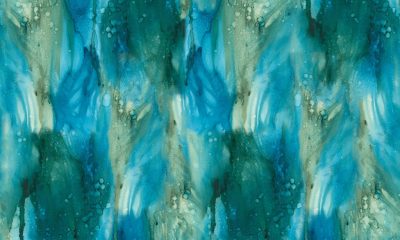What is Creative Retail Design?
In recent years the retail concept design process has been refined and perfected by brands while, at the same time, has also become more competitive than ever before. This competitive trend will become even more important after Covid-19. As a response to the pandemic, offline retailers who were not yet utilizing omni-channelling as means of sales, quickly transitioned their operational strategies to provide their consumers access to their products online. Since consumers can order literally everything from their homes, they will be investing in experiences over products when they go to retail stores. Retailers that can’t meet customer’s expectations will have to step up or step out.
Creative retail design is a memorable, unique design style that enhances brand recognition and customer loyalty by providing customers with interaction and experience through technology integration, personalization, or an unusual interior design concept. The benefit of investing in creative retail is the increased brand recognition, customer loyalty, and sales. It also helps the brand to stand out from their competitors in the market.
Creative Design Methods
A major challenge for retailers is getting customers through the door of their physical retail store. According to a recent survey (Wiser, 2019) when it comes to impulse shopping, 89 percent of women and 78 percent of men purchase additional items beyond their identified need when they enter a physical retail store. In order to succeed brands try to create an immersive environment with convenience-focused arrangements that utilize most up-to-date technology. We would like to introduce a few different methods that give a really good idea about creative retail design
1. Hybrid solutions
Hybrid solutions mean the approach of combining multiple services under one roof. This can be the combination of a shop, a cafe, and a co-working space, or a shop, a tea bar and lounge room, as well as a restaurant and coffee-flower shop. Incorporating these slow-shopping methods into the retail design increases the overall customer time spent in the store which enhances their consumer journey and increases their likelihood of purchases goods. Only the imagination sets the limit of these combinations.
2. Technology
Customers look for inspiration when it comes to experience. It can be in a form of a smart makeup mirror at a cosmetics store, to an app that offers customers to virtually “try on” the products. Magic mirrors, virtual dressing rooms, and various other types of augmented reality experiences are often seen as the next wave of consumer expectation.
Virtual reality can increase sales in a remarkably creative way. A good example is KITKAT Chocolatier’s experience in São Paulo where the whole space is filled with product gamification, personalization, creative AR hotspots and VR tour in order to delight visitors. Since its launch, the store has welcomed more than 300,000 guests, reached 40,000 mentions on Google Search and has racked up thousands of followers and tags on Instagram, because of the direct effect of their unique, technology and experience oriented design.
Advertisement
3. Customer Interaction and Personalization
Brands are trying to engage customers during their customer journey. A good example of how to involve customers is Neiman Marcus’s store front that invites kids to climb into a tunnel, peek into the store and then go down on a slide back to the sidewalk. Meanwhile, their parents can control special effects inside the display or place themselves in space scenes by using their camera.
Best Practices from China
Our first showcase is a multipurpose retail space in Shanghai’s downtown area. The area includes a shop, a tea bar, a lounge room and a restaurant. The main concept of the space is developed from minimalism. The vision for the retail area is to create a harmonious and relaxing environment where visitors can turn off a bit and feel creative.
The interior of the luxurious Italian brand, Valextra has a library style design in a shopping center in Chengdu. The whole design style has a strongly romantic approach while channeling functionality, precision and overall passion combined into a library-style interior. Building on this motif, the retail space is divided into the library area and the reading room. The “library area” is a circular space that displays the luxurious products on walnut shelves, while the reading room showcases units that boasts the most exclusive designs.
Chongqing Zhongshuge Bookstore in Southwest China provides space to read and study. It also includes a children's reading room and a social area. The overall feeling of the space is mysterious wonderland. The center of the store is a double-height hall, which features horizontal and vertical sets of stairs where visitors are encouraged to rest and read. Mirrored panels on the ceiling increase the size of the room and multiply the number of staircases. This central space is meant to reflect the stepped outline of Chongqing's landscape.
What is the Future of Retail Design?
Looking ahead, the challenge for evolving retail store design is to keep up with the rapid transformation we are experiencing now. Brands will constantly need to create new ways of attracting visitors and provide them with unique experience.
According to the Consumer View report (National Retail Federation, 2019), 55 percent of millennials consider shopping in stores as a social activity and 66 percent prefers to shop in-store than online. This means that brick-and-mortar retail still has a lot of possibly yet to be tapped. The report also found that retailers who invested in technology and in-store experiences could reach a really good ROI. As a result, we can conclude that consumers are spending more on experiences than ever before, and retailers who can meet the demand in a creative manner, while also staying loyal to their brand identity are the ones who will rise above their competitors.
Advertisement
Image Source: Dezeen
Image Source: Trendhunter
Image Source: Weburbanist
Image Source: Fitch
“Clothing store in Hangzhou”
Image Source: Weburbanist
Advertisement
“Bookstore Design in Zhongshu”
Image Source: Trendhunter
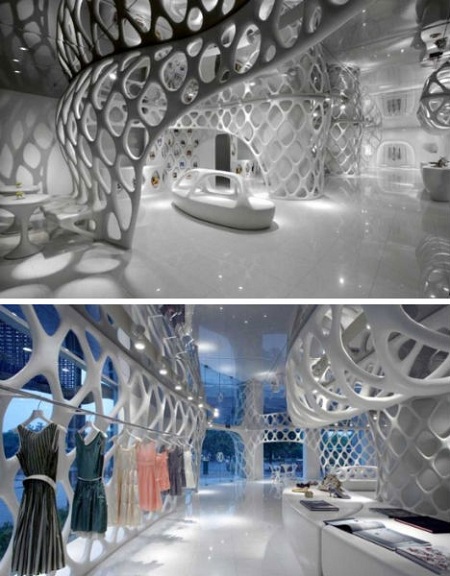

 Photo Gallery3 days ago
Photo Gallery3 days ago
 Headlines2 weeks ago
Headlines2 weeks ago
 Sector Spotlight2 weeks ago
Sector Spotlight2 weeks ago
 Headlines1 week ago
Headlines1 week ago
 Headlines5 days ago
Headlines5 days ago
 Headlines2 weeks ago
Headlines2 weeks ago
 Designer Dozen1 week ago
Designer Dozen1 week ago
 Headlines3 days ago
Headlines3 days ago
